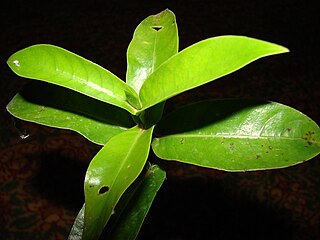
A species that is extinct in the wild (EW) is one that has been categorized by the International Union for Conservation of Nature as known only by living members kept in captivity or as a naturalized population outside its historic range due to massive habitat loss.

Juania australis, the Chonta palm, is a species of flowering plant in the family Arecaceae, the only species in the genus Juania. It is a solitary trunked palm tree which is endemic to the Juan Fernández Islands archipelago in the southeast Pacific Ocean west of Chile.

Satakentia liukiuensis, is a species of palm tree. They are endemic to Ishigaki Island and Iriomote Island in the Yaeyama Islands, the south-westernmost of the Ryukyu Islands, Japan. It is the only species in the genus Satakentia.

The Bounty shag, also known as the Bounty Island shag, is a species of cormorant of the family Phalacrocoracidae. They are found only on the tiny and remote Subantarctic Bounty Islands, 670 km southeast of New Zealand. Its natural habitats are open seas and rocky shores. In 2005 618 individuals were counted and the population seems to have remained stable since.
Geniostoma astylum is a species of plant in the Loganiaceae family. It is endemic to French Polynesia.

Geniostoma is a genus of around 25 species of flowering plants in the family Loganiaceae. They are shrubs or small trees, with inflorescences borne in the axils of the simple, petiolate, oppositely-arranged leaves. The flowers are arranged in cymes, and each is pentamerous.
Geniostoma clavigerum is a species of plant in the Loganiaceae family. It is endemic to Fiji.
Geniostoma confertiflorum is a species of plant in the Loganiaceae family endemic to Fiji.
Geniostoma macrophyllum is a species of plant in the Loganiaceae family. It is endemic to Fiji.
Geniostoma quadrangulare is a species of plant in the Loganiaceae family. It is endemic to French Polynesia.
Geniostoma rapense is a species of plant in the Loganiaceae family. It is a shrub endemic to the island of Rapa Iti in the Tubuai Islands of French Polynesia.
Geniostoma stipulare is a species of plant in the Loganiaceae family. It is endemic to Fiji.
Geniostoma umbellatum is a species of plant in the Loganiaceae family. It is endemic to Papua New Guinea.
Geniostoma uninervium is a species of flowering plant in the Loganiaceae family. It is endemic to Fiji.

Labordia is a genus of plant in family Loganiaceae. There are 16 species all endemic to Hawaii. It is closely related to Geniostoma

The small white-winged flying fox is a species of megabat in the family Pteropodidae. It is known from Mindoro Island, in the Philippines. Only 13 specimens have ever been found; one in 1998 and the others in 2006.

Geniostoma ligustrifolium, commonly known as hangehange, is a species of plant in the Loganiaceae family. It is endemic to New Zealand, where it is found on the North Island, and in Marlborough at the northern tip of the South Island. Other common names are pāpā and privet leaf. A shrub common on forest margins, to 4 metres (13 ft) tall. It is popular as a garden specimen.
Geniostoma huttonii is a flowering plant in the Loganiaceae family. The specific epithet honours Ian Hutton who discovered the species in the course of his explorations of the Island.
Barry John Conn, is an Australian botanist. He was awarded a Ph.D. from Adelaide University in 1982 for work on Prostanthera.

Geniostoma sykesii is a species of flowering plant in the family Loganiaceae, endemic to the islands of Mangaia and Mitiaro in the Cook Islands. It grows on makatea terrain. Its dried leaves are used in ‘ei, and used to scent multiple products.








